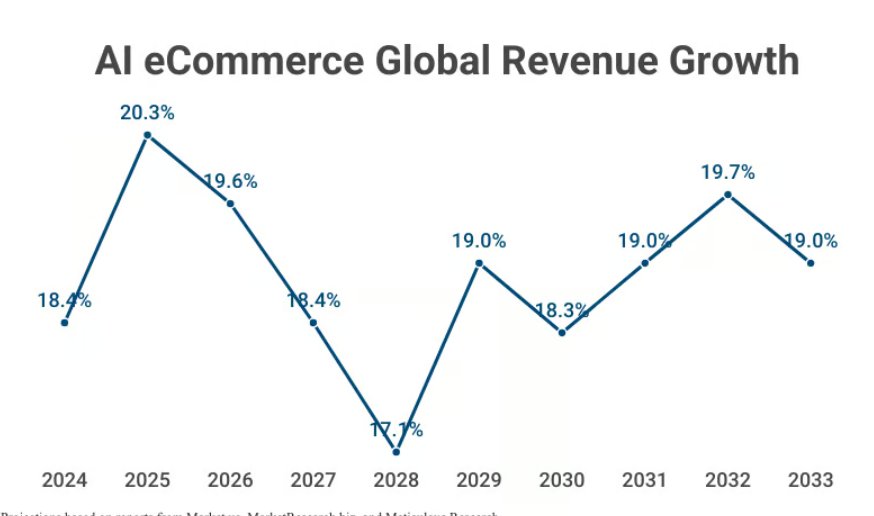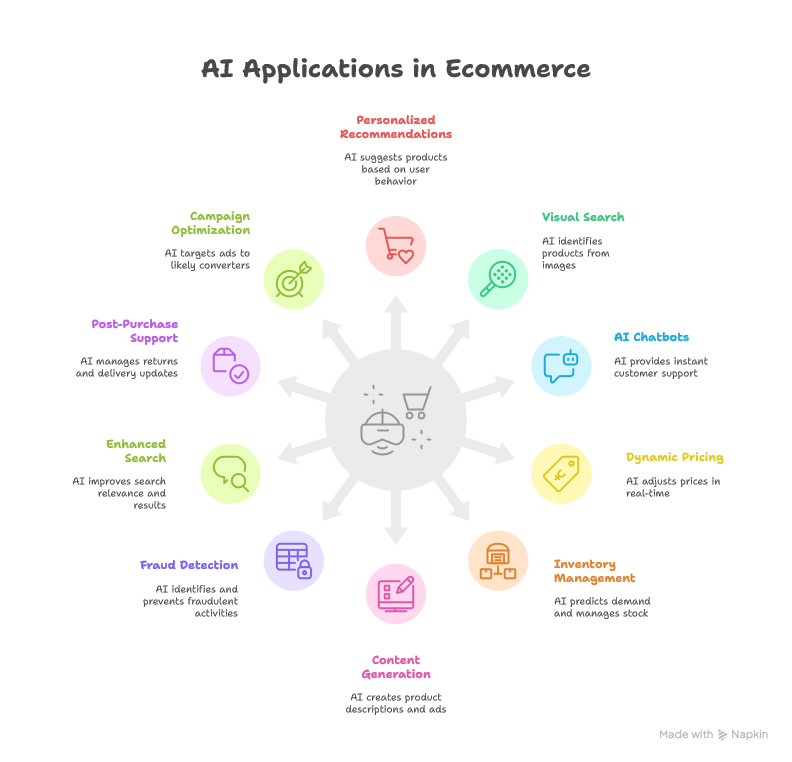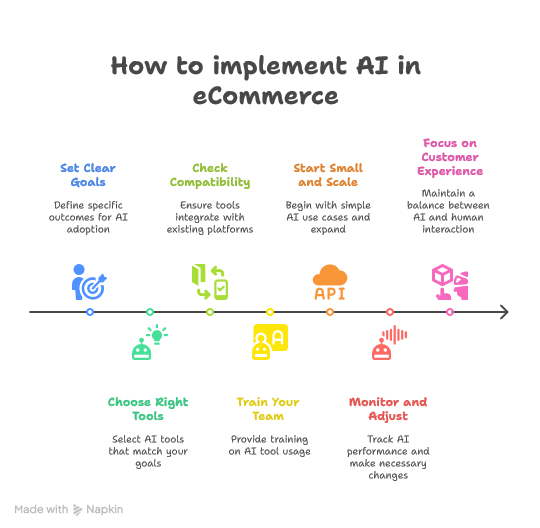
Discover how to use AI in eCommerce in 2025 to personalize shopping, automate operations, and improve customer experiences across the full buyer journey.
What sets a top-performing online store apart in 2025? AI now plays a central role in how eCommerce teams engage customers, run logistics, and adapt in real time. It powers search, predicts customer intent, and personalizes every step of the buying journey. Businesses that adopt these tools gain speed, precision, and a deeper connection with their audience. In this guide, we’ll walk through the most practical ways to use AI in eCommerce today—backed by current trends, real-world tools, and results that show what’s possible when teams use AI with purpose.
The role of AI in ecommerce today
AI has become the backbone of modern eCommerce. From product discovery and customer service to backend logistics, AI supports decisions that once took hours—or teams—to make. According to a report, in 2025, more than 84% of online retailers already use AI to drive growth, and the global eCommerce AI market is projected to surpass $45 billion by 2032.

Platforms like Amazon, Shopify, and Magento now offer native AI tools, while custom generative AI development solutions give teams more control over how they scale content, automate merchandising, and optimize campaigns. AI allows businesses to analyze behavioral data at scale and respond instantly with personalized product suggestions, dynamic pricing, and targeted offers. Here are the key benefits of using AI in eCommerce:
- Hyper-personalized shopping experiences that reflect individual behavior, preferences, and intent.
- Real-time pricing adjustments based on market demand, competitor pricing, and stock levels.
- Smart fraud detection using behavioral analysis, purchase patterns, and transaction data.
- Automated inventory forecasting that reduces overstocking, avoids stockouts, and improves margins.
- AI-generated content for product descriptions, marketing copy, and visuals to scale launches faster.
- Predictive analytics that guide marketing campaigns, customer segmentation, and LTV strategies.
- Visual search tools that let users shop with images instead of text-based queries.
- 24/7 AI-powered customer support through multilingual chatbots and virtual assistants.
- Dynamic landing pages and ad personalization that improve conversion rates across paid channels.
- Post-purchase automation including delivery tracking, return handling, and review requests.
As eCommerce grows more competitive, AI becomes less of a bonus and more of a requirement. Businesses that adopt AI strategically gain speed, accuracy, and insight across every touchpoint—from the first click to the last mile. The companies leading in 2025 aren’t just using ai in e-commerce, they’re building with it, automating smarter, and shaping better customer experiences by design.
Top use cases of AI in ecommerce
AI reshapes how eCommerce businesses operate, far beyond automation. It makes everyday decisions smarter and delivers experiences that feel personal, relevant, and seamless. In 2025, the most successful stores use AI not as an extra layer, but as the foundation that powers their storefronts, supply chains, and customer engagement strategies. During peak events like BFCM in e-commerce, these tools help manage demand and deliver real-time experiences at scale. Below are 10 different ways how to use AI in eCommerce.

1. Hyper-personalized product recommendations
AI for ecommerce tracks user behavior, purchasing history, browsing habits, and even demographic indicators to generate custom product suggestions in real time. These systems continuously adapt, learning from every click, scroll, and interaction. According to Salesforce, personalized recommendations now influence 24% of total orders and account for 26% of total revenue. Tools like Dynamic Yield, Nosto, and Algolia Recommend power these systems for platforms such as Shopify and Magento, enabling merchants to show “just-right” products that drive larger carts and repeat visits. Teams can also integrate Pulse survey tools to gather feedback on recommendation quality and refine the experience over time
2. Visual search and image recognition
Shoppers now use their phone cameras to search for products, bypassing the need to describe complex items with words. AI visual search engines like Google Lens, Pinterest Lens, and Amazon Camera Search match user-uploaded images to catalog items using deep learning and computer vision. This functionality is especially valuable for categories like fashion, furniture, and home décor. Retailers report that visual search shortens the time to purchase and increases conversion rates, particularly on mobile.
3. AI-powered chatbots and virtual assistants
Customers expect instant answers. AI-driven chatbots like Tidio, Zendesk AI, and Drift handle pre-sale questions, resolve support issues, and guide users through the checkout process. Virtual assistants can also manage returns, recommend products, and provide order updates. By using conversational AI, businesses reduce support load, deliver 24/7 service, and improve response times without growing their support team. These assistants now handle over 80% of standard customer queries across retail platforms.
4. Dynamic pricing optimization
AI enables real-time pricing that reflects current demand, competitor moves, inventory levels, and user-specific factors. This is already core to how companies like Amazon operate, updating millions of price points daily. AI pricing tools like Prisync, Wiser, and Intelligencenode help smaller brands stay competitive by automatically adjusting prices and maintaining profit margins. Retailers using dynamic pricing strategies report increased revenue and faster stock turnover without sacrificing user trust.
5. Inventory management and demand forecasting
Inventory mismanagement—overstocking slow products or running out of bestsellers—can break an eCommerce operation. AI uses past sales, browsing trends, customer locations, and event calendars to predict demand before it happens. These systems help retailers plan restocks, prepare for seasonal shifts, and align warehousing decisions with actual buying patterns. Tools like Inventoro, Relex, and predictive models built into enterprise platforms give operations teams more control without guesswork
6. AI-generated content and creative automation
From product descriptions and meta tags to email copy and banner ads, AI can generate high-quality content that matches a brand’s tone and structure. This reduces production time and keeps content fresh across thousands of SKUs. Solutions like Jasper AI, Copy.ai, and Shopify Magic enable merchants to launch new products faster and improve SEO rankings. AI also generates alternative headlines, A/B testing variants, and promotional language to increase engagement.
7. Intelligent fraud detection and risk analysis
AI reviews behavior patterns in real time to spot unusual activity, such as mismatched IP addresses, large-volume orders, or repeated failed payments. These systems flag transactions for review or stop them automatically, which can reduce chargebacks and protect both the store and the buyer. Unlike rule-based systems, AI models improve as they process more data, adapting to evolving fraud methods. Vendors like Signifyd and Riskified integrate directly with major eCommerce platforms to automate protection with minimal manual review.
8. AI-powered search and navigation
Basic search bars often miss the mark when shoppers type vague or misspelled queries. AI-powered search understands intent, context, and user history to return more relevant results—even when the input is unclear. Tools like Algolia, Klevu, and Elasticsearch improve product discovery by refining ranking, filtering, and suggestion logic. These solutions also personalize search results, showing items most likely to match each visitor’s interests.
9. Post-purchase support and engagement
AI continues to deliver value after checkout. It handles return requests, recommends related products based on purchases, and manages delivery updates across channels. This builds loyalty through smoother support and better communication. Tools like Narvar, Loop Returns, and AfterShip use AI to adapt workflows to each customer’s experience, automating what used to require multiple support reps and manual systems.
10. Campaign optimization and Ad targeting
AI segments audiences, adjusts ad placement, and tunes creative elements based on real-time engagement. Platforms like Google Ads and Meta Ads use machine learning to deliver ads to shoppers most likely to convert, using signals like browsing history, page visits, and session patterns. This automation helps marketing teams improve performance and scale campaigns faster, with less manual testing.
Each use case shows a shift from manual decisions to intelligent automation. Businesses that adopt these AI applications do more than add tools—they rebuild operations so they match how people shop, search, and interact in 2025. The outcome: faster workflows, smarter resource allocation, and customer experiences that feel effortless and personal.
How to implement AI in your ecommerce business
AI works best when it solves specific problems, not when it’s added just for trend’s sake. Successful eCommerce teams start by identifying the areas where AI can deliver measurable results. From customer service automation to smarter product recommendations, each use case requires the right setup, tools, and expectations. Here’s AI ecommerce implementation guide:

- Set clear goals for AI adoption. Start with specific outcomes. Do you want to reduce returns, improve ad performance, personalize recommendations, or speed up support? For example, a growing store might focus on AI chatbots to handle customer questions, while a large retailer could prioritize inventory forecasting or dynamic pricing.
- Choose the right AI tools. Match tools to your goals. If you need automated product recommendations, consider Dynamic Yield or Clerk.io. For fraud detection, you can use Signifyd or Riskified. For visual search, look at platforms like Clarifai. Use AI-powered content generators like Jasper or Writesonic to speed up product page creation.
- Check platform compatibility. Confirm that the AI tools you choose integrate with your existing eCommerce platform—whether it’s Shopify, WooCommerce, Magento, or a custom build. Look for APIs, plugins, and support for key systems like CRMs and ERPs.
- Train your team. Even the best AI won’t help if your team doesn’t know how to use it. Provide basic training on how to interpret AI-generated insights and when to intervene manually. Marketing, support, and fulfillment teams should all understand the changes AI brings to their workflows.
- Start small and scale gradually. Test one AI use case at a time. Begin with a tool that offers clear ROI, like an abandoned cart recovery bot or smart product tagging, and expand to more complex solutions once results are measurable.
- Monitor and adjust. Track the impact of AI tools using metrics like conversion rate, average order value, return rate, or ticket resolution time. If performance stalls, adjust configurations or retrain the models with updated data.
- Stay focused on customer experience. AI should assist—not replace—the human touch. Use automation to remove friction, but make sure customers still feel seen and supported. Maintain options for live chat or manual overrides where needed.
AI implementation works best when it is tied to real business problems. Businesses that move methodically—start with clear goals, match the right tools, and learn along the way—already see faster growth, lower costs, and greater customer loyalty. In a competitive eCommerce environment, thoughtful AI use acts as a multiplier across every part of your business.
Conclusion
The best results come from using AI with clear intent. Start with a specific goal, choose the right tools, and focus on measurable outcomes. Businesses that approach AI this way improve performance and build a foundation for long-term adaptability. In 2025, using AI in eCommerce is no longer optional. It defines how the most successful brands deliver value to their customers and stay ahead in a crowded market. The opportunity is clear—and it’s already in motion.
FAQ
What are the most useful AI tools for eCommerce in 2025?
The most useful AI tools in 2025 depend on the area of focus. For product recommendations and personalization, platforms like Dynamic Yield and Nosto deliver tailored experiences. For customer service, tools like Zendesk AI and Tidio automate support across channels. Jasper AI and Shopify Magic help create product content, while Prisync handles real-time pricing. Inventory forecasting tools like Inventoro improve stock planning and reduce waste. These tools cover both storefront and backend needs, giving eCommerce teams the ability to move faster.
Is AI expensive to implement for small businesses?
AI adoption no longer requires enterprise budgets. Many eCommerce platforms now include built-in AI features, and third-party tools offer flexible pricing for small teams. Chatbots, recommendation engines, and AI content generators often start with free tiers or usage-based plans. While advanced customization or large-scale automation may require investment, most businesses can begin with targeted use cases that bring quick value without overextending resources.
Can AI replace human customer support?
AI can automate many support tasks, including order tracking, returns, and product questions, especially during off-hours or peak periods. However, it complements rather than replaces human agents. AI handles repetitive or time-sensitive queries, while humans manage complex cases or emotional interactions. A hybrid approach leads to faster response times, reduced costs, and a better overall experience for the customer.
Was this news helpful?







 Yes, great stuff!
Yes, great stuff! I’m not sure
I’m not sure No, doesn’t relate
No, doesn’t relate



